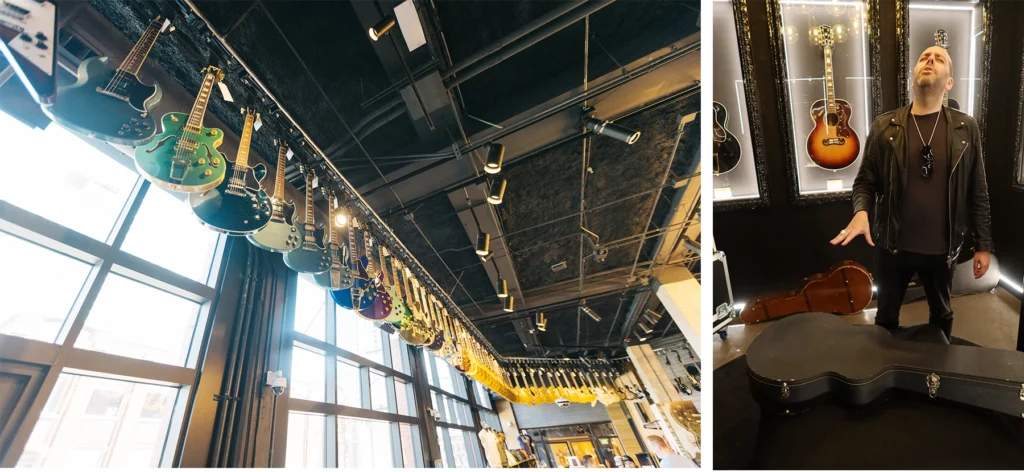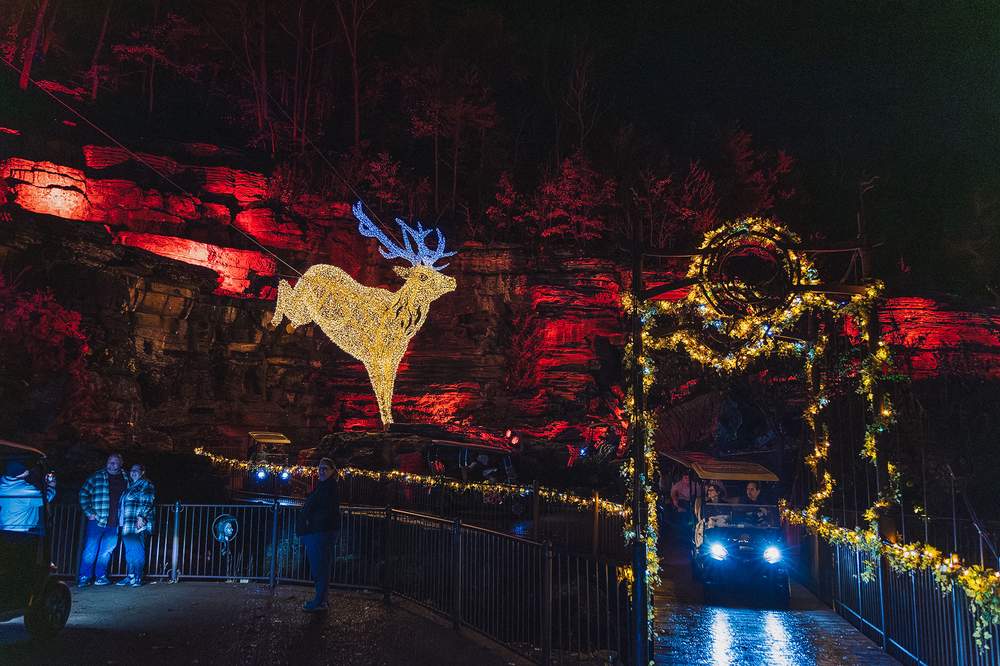Click to listen to the audio version of this article.
Tour Gibson Garage, Plus Three More Must-Hit Food & Drink Joints In Nashville
Hundreds of shiny guitars circle the ceiling on a conveyor belt at Nashville’s Gibson Garage, also known as Guitar Heaven. Guitars adorn the walls, ranging from priceless vintage instruments to fresh new models and ’80s-inspired electric screamers. Players test out guitars with Ozzy’s “Crazy Train” and geek out in deep conversations with the store’s experts. Shoppers pick up souvenir straps, strings, or onesies for their tiny future rock stars. In the Custom Shop, people are crafting their dream guitars.

Located in the Gulch neighborhood just south of downtown, Gibson Garage serves as the 8,000-square-foot flagship store for all Gibson brands, including Epiphone and Kramer. Situated in historic Cummins Station, a former railroad warehouse that once teemed with freight and cattle, it is now the epicenter for guitars. This spectacular showroom operates by day and transforms into a music venue by night, hosting top-tier performers like Slash, Peter Frampton, Chris Isaak, Cheap Trick, Jason Isbell, and Sheryl Crow.
“And that’s just in the last few months,” says Mark Agnesi, director of brand experience and designer of the Gibson Garage. Agnesi radiates rock and roll. He’s effusive in his love for guitars and for Gibson, the company founded in 1894 by Orville Gibson. “We’re 131 years old this year. We predate recorded music, which means ever since music has been recorded, it has been made with Gibson instruments,” he says. “Basically, all the music you’ve ever heard your entire life is because Gibson invented stuff.”
Birth Of An American Icon
Guitars originated in the 1400s but were quiet instruments, suitable only to play for a few friends in your living room. Orville Gibson, a clerk and tinkerer with no formal training, thought he could improve the guitar’s design and construct something new. He had one innovation that completely changed the game: the carved top. Inspired by the violin, his guitar had a solid rim, a thinner body, and a carved, arched top to amplify sound waves. Gibson’s guitar was over twice as loud—and a hit. For the very first time ever, guitars went on stage.
Orville died in 1918, but his company kept innovating. Gibson Guitars introduced the adjustable truss rod in 1921, a stabilizing metal bar inside the instrument’s neck.
“Because we now have steel reinforcement, we can start making guitar necks thinner, which allowed guitar players to play further and further up the neck … and ultimately, the guitar solo is born,” Agnesi says. “You’re welcome.”

Gibson then invented the L-5 guitar, the first to feature F-holes instead of a round sound hole. The instrument’s volume doubled once more. Next came the ES-150, the first hollow-body electric guitar, followed by the iconic Gibson Les Paul. Debuting in 1952, the solid-body guitar achieved immediate success due to its versatility, incredible tone, and distinctive cutaways. Soon after, the sleek SG model was introduced, characterized by double cutaways and a lighter, fast-playing design—becoming a favorite among rock musicians.
Order A Custom Gibson Guitar
No matter which model moves you most, you can create a one-of-a-kind guitar and control every aspect at Gibson’s Custom Shop.
“Most of what we do at the Custom Shop is making exact one-to-one recreations of original vintage guitars, whether that’s a 1959 Les Paul, a 1964 Trini Lopez, a 1963 Firebird V or a 1958 Flying V,” Agnesi says.
“We have this incredible 3D scanning technology that allows us to take digital blueprints from original examples. It tells us the exact geometry.” Replicas are aged with burnished edges or chipping paint; Eric Clapton’s 1958 Les Paul custom comes with cigarette burns on the headstock.
You can also design a guitar from scratch, beginning with the wood. “The 1959 Les Paul is kind of the star of the show, and on these guitars, it’s all about that wood grain,” Agnesi says. “Some people want really tight flames, some people want big white chevron flames.”

Eastern maple and Western maple are popular, and exotics like Hawaiian koa and quilted maple are also available. “The Gibson Garage in Nashville and London are the only two places in the world where you can actually hand-select parts and wood for guitars,” Agnesi says. Can’t travel? You can also “visit” the Custom Shop on a video call.
After wood, you choose a neck profile. “You get exactly what neck feels right to you,” Agnesi says. If you’re making a 1959 Les Paul but don’t love the feel of the neck, you can opt for a fatter, early-50s-style neck or a skinnier, late-60s-style taper. Color comes next. There’s lemon burst, dirty lemon burst, and green lemon burst—or deep cherry, washed cherry, and faded cherry. Different shades represent different levels of fading on vintage guitars so that custom instruments can accurately reflect the aging process. For example, a 1959 Les Paul would have gradually faded from cherry red to lemon.
“We make 16 different approximations of what would happen to that guitar over the course of the last 65 years,” Agnesi says. “Because we guitar players are that particular.”
Agnesi continues, “Then comes the real fun stuff … we get to spec out every single piece. Knobs, tuners and pickups. Chrome, nickel, or gold. White or black plastics. And finally, the finish. Do you want it shiny and brand new? Do you want ultra-light aging, light aging, heavy aging, or ultra-heavy aging? Do you want it to look like it sat in a case in a closet for 60 years, and you just discovered it? Or do you want it to look like it was on stage every night for the last 60 years making music, with arm wear and belt buckle rash and playwear on the back?”
Custom guitars start at approximately $7,000 for a basic 1959 Les Paul and require a minimum of six weeks. You’ll wait a bit longer for ultra-heavy aging or to have your name inlaid on the fingerboard.
Even if you’re not shopping for a guitar—or you don’t even play one—Gibson Garage is a fascinating dive into music culture. “More music has been made with Gibson instruments than any other brand. It’s not even debatable,” Agnesi says. “But not just that: The genres themselves that we listen to were created with Gibson.”
Modern blues music, country, bluegrass, rockabilly, rock, heavy metal, and pop rock were all pioneered by artists playing Gibson instruments. They didn’t just make music; they made magic—and at Gibson Garage, that magic is alive and well.

Three Great Nashville “Gulch” Hotspots
The Gulch is one of Nashville’s most vibrant neighborhoods, a former industrial zone transformed into a walkable urban enclave with colorful murals, music venues, and plenty of bars and restaurants. You’ll not regret a visit to any one of the following.
Tennessee Brew Works: Housed in a century-old building, this microbrewery cooks up craft libations with natural ingredients from local farms. Try the refreshing State Park Blonde Ale, made with 100% Tennessee grains, or go for the best-selling Cowboys & Hippies—a crisp, citrusy IPA perfect for sipping on the brewery’s patio. (tnbrew.com)
Station Inn: Music is the focus at this intimate, old-school listening room, which hosts bluegrass, roots, country, and Americana artists seven nights a week. For 40 years, it’s been a low-key place to catch top talent and up-and-comers while you drink a beverage or two. All tickets are first-come, first-served. (stationinn.com)
Biscuit Love: Southern brunch favorites get twisted at this award-winning restaurant. Decadent biscuit sandwiches include the Princess (with Nashville hot chicken) and the East Nasty (with creamy sausage gravy). Can’t decide between the two? Order the Nasty Princess, an off-menu item that combines the best of each. (biscuitlove.com)



